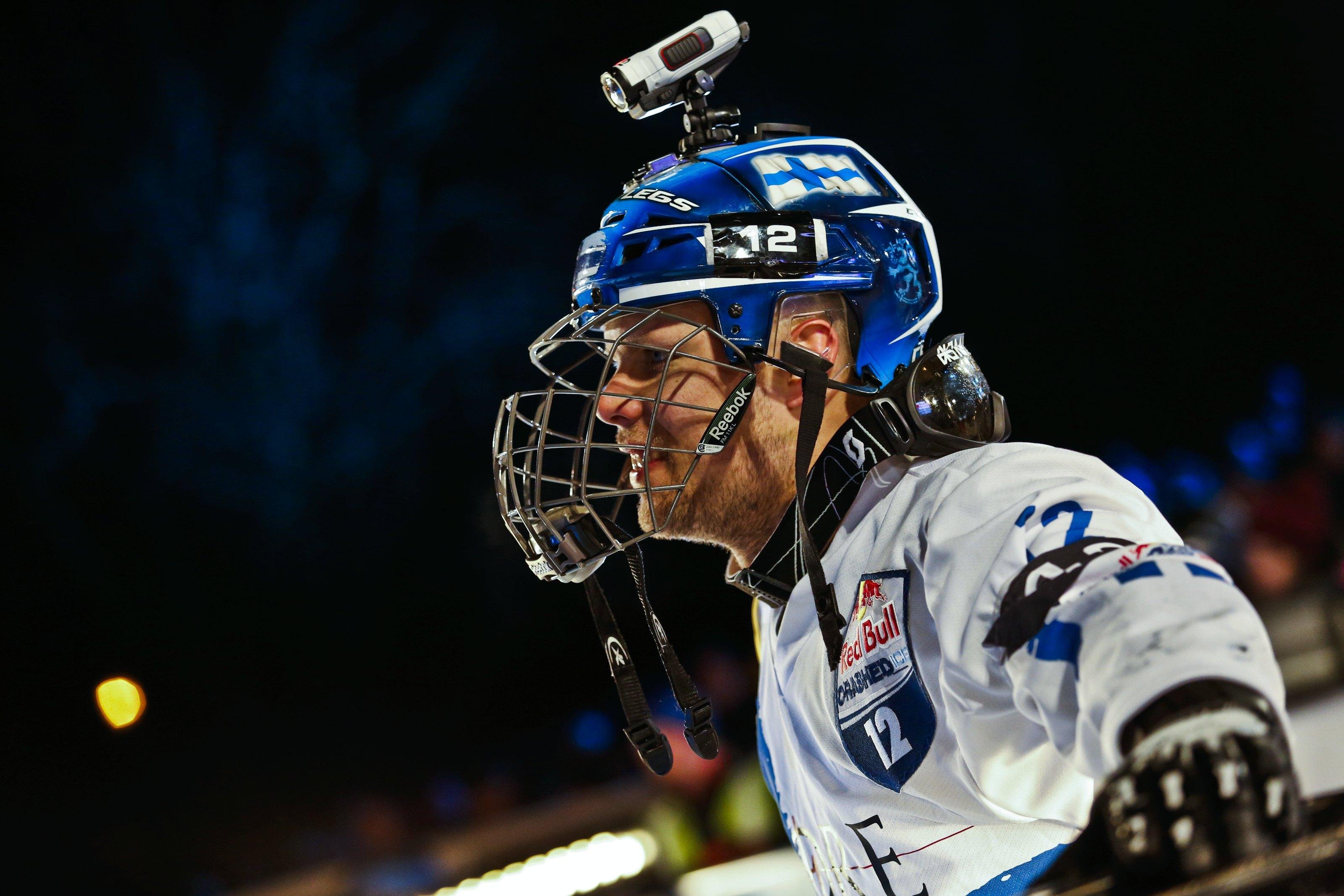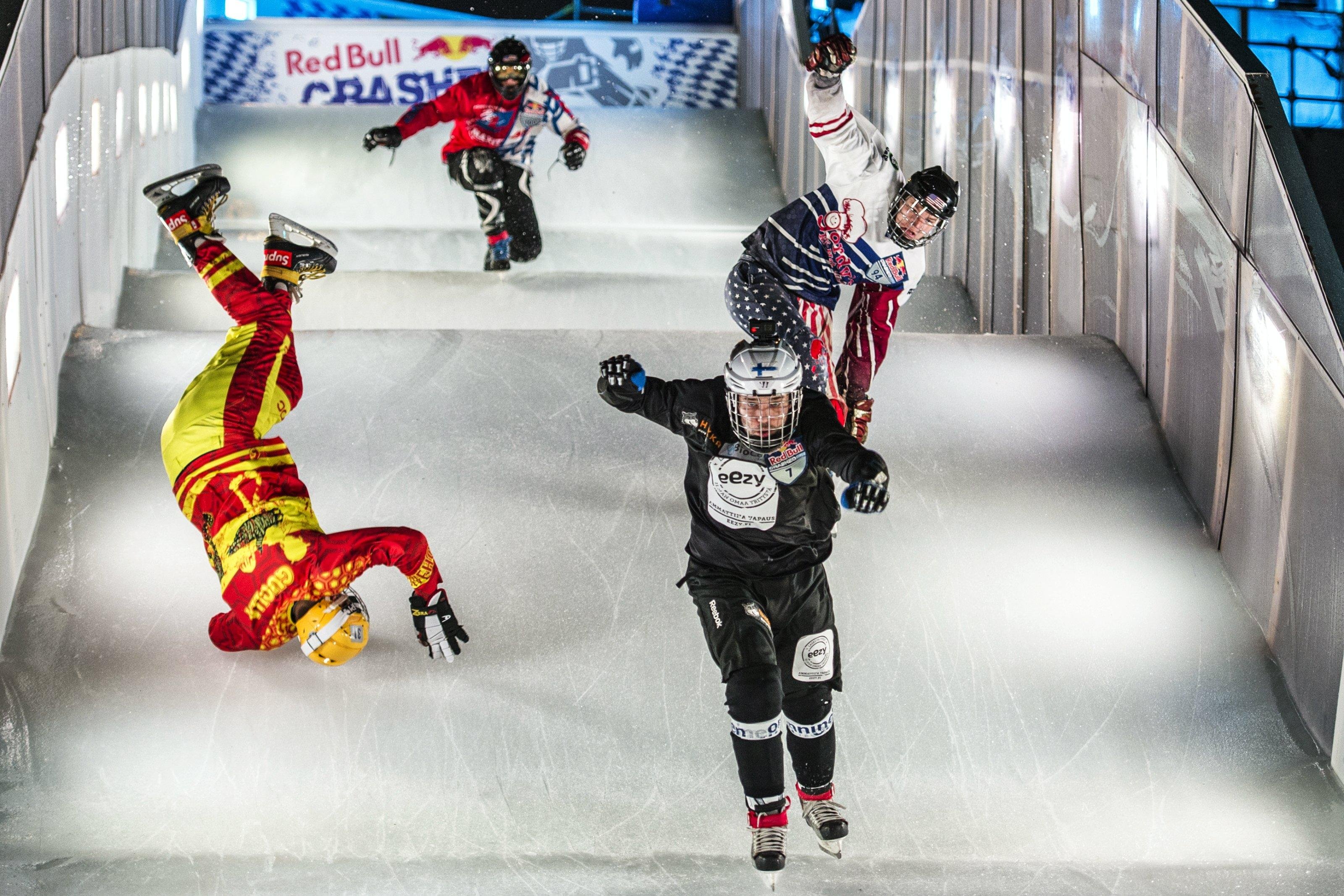Ice Cross Downhill is high speeds, tough competition and having fun with your friends. But being successful in the world's fastest sport on skates doesn't come easy. It takes hard work – both on and off the track. The experienced athletes Miikka Jouhkimainen and Paavo Klintrup, who are among the most successful Finnish ice cross downhill aces, know this very well.
Miikka Jouhkimainen (31) and Paavo Klintrup (27) are members of the Finnish ice cross downhill elite. Between them, the pair have scored victories as well as several places in the quarterfinals and finals, and this year they began their 10thRed Bull Crashed Ice season. These guys know that climbing all the way to the top of the ice cross downhill ladder, so to speak, takes hard work. Ice-skating downhill alone is not enough – in addition to speed, a balance between training, competing, backers, media visibility and private life is vital.
For the Red Bull Crashed Ice athletes, ice cross downhill is not just a winter sport. "I always try to spend as much time on my skates as possible, and I go to the gym regularly about five times a week. I'm responsible for my own training and I do it based on how I feel", Klintrup, the guy from Oulu in Northern Finland, describes the year-round requirements of the sport. Jouhkimainen, who lives in Helsinki, says that he too is responsible for his own sport-specific training, but his physical training is done together with two coaches. "At the Core Trainers gym, Thomas, Matti and Ville tune me into top shape physically. I have a comprehensive training programme that utilises a variety of different sports. This year I have also started to do mental training with Zermatt's Johanna Konttila", says Jouhkimainen.

You can get versatility into your training year-round with e.g. hill training. Paavo Klintrup, Iivo Niskanen (Finnish Olympic gold medallist in cross-country skiing) and Miikka Jouhkimainen on a ski jump in Kuopio, Finland, at a Red Bull 400 event. Photo: Victor Engström/Red Bull Content Pool.
The importance of keeping your head in check is increasing due to the intense race schedule. "If your head is not always ready, the winter flies by in a flash. You have to be able to forget the previous race very quickly and immediately start to concentrate on the next one", Jouhkimainen continues. The fast pace of the race calendar as well as travelling abroad for competitions require a lot of resources. The athletes should get to the venues in good time, as getting to know the track, finalising the race strategy and fine-tuning your body into shape for the race takes time. Also, adapting to time zone changes presents its own challenges when travelling to and from North America.
However, the physical and mental abilities alone are not enough to get you to the very top – and stay there. Both Klintrup, who works as a police officer, and Jouhkimainen, the owner of a video production company, organise their 'civilian work' so that during winter they can for the most part focus on ice cross downhill. It is not always easy. "Sponsors are really important. Thanks to them, it is possible for me to concentrate on ice cross downhill during the winter. As an individual athlete, I have to do quite a bit of work myself for getting sponsors", ponders Jouhkimainen. "I always schedule my annual leave for the busiest time of the season", says Klintrup for his part. Success on the ice tracks in turn makes the sponsors more interested in the athletes. "If you want this sport to grow, you have to be successful. That's a fact", says Klintrup. "Big thanks must also be given to the Finnish All Terrain Skate Cross (ATSX) Association for establishing the sport in Finland and for making it grow. Those guys, with Arttu Pihlainen as a spearhead, are doing selfless work that is helping us all", he continues.

Jouhkimainen knows that during the intense season, athletes must keep a cool head and not lose their concentration. Photo: Daniel Grund/Red Bull Content Pool.
Being successful in a sport that is popular with the fans brings about visibility and exposure. Meeting the requirements of social media is a part of the athlete's professionalism. Even though top Finnish ice cross downhill racers might not feel comfortable with the media attention, it's a part of their career. "The rise of social media has brought about new demands. I will try to meet them, even if it doesn't always feel totally comfortable. I wish people will see that I'm a bit crazy, but skilful", Jouhkimainen sums up his media personality. His fellow competitor Klintrup describes himself as an ambitious but humble hard worker. "Fame brought on by success is good for the sport, but I wouldn't want to put myself up on a pedestal, even if I was successful", Klintrup says.
Even working hard as ice doesn't feel that hard when you get to do what you love. "It's pretty damn cool to be an ice cross downhill athlete. This is the sport that I love the most", says Jouhkimainen who has a background in ice-hockey. Klintrup is also along the same lines. "It's great to be building and developing this sport. Even though my racing career is still going strong, I already feel a bit nostalgic about ice cross downhill. It has given me awesome experiences by the bucketload", says Klintrup.

Klintrup wants to stay humble in spite of success. Photo: Predrag Vuckovic/Red Bull Content Pool.
These fast and ambitious Finns head for the upcoming competitions with a strong attitude and the same goal in mind. Jouhkimainen has already got two of them – from 2008 and 2009 – Klintrup is still hungry for his first one. "Yes, I would very much like to score a win in a Red Bull Crashed Ice competition", both men say in unison. Their next chance for making it happen is next Saturday on their home turf in Jyväskylä.



